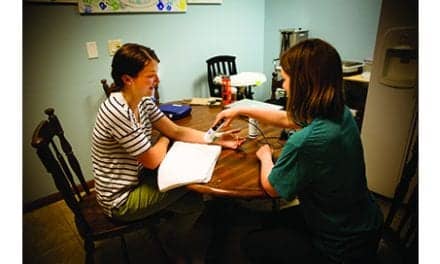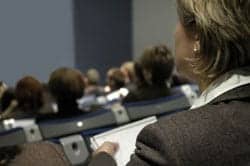The use of aquatic therapy can revitalize and amplify athletic performance.
by Lance Walker, MS, PT,
To the coach, an athlete’s muscles are like tiny computers: they must periodically be rebooted. Sometimes, it may even be necessary to press CTRL-ALT-DEL to shock those muscles into a re-set mode. The end goals for musculature, as for a laptop, are ultimately the same: recovery and readiness.
There are numerous theories in the athletic realm concerning how best to help muscles recover and prepare to be used again, but one that has become a mainstay for professional athletes from every sport is the use of aquatic exercises and treatments. At our facility, we have three distinct methods of utilizing aquatics to help athletes recover faster: 1) Tissue preparation; 2) Tissue regeneration; and 3) Active recovery.
Preparing the Muscles for Workouts
As unusual as it sounds, a highly effective method to prepare for intense exercise is to begin the recovery process before the athlete engages in any kind of physical activity. By helping the body heal prior to muscle tissue breakdown, the athlete can set the stage for exceptional results.
One of the best types of aquatic “tissue wake-up call” athletes 18 years old and older can have is via a thermal plunge pool. For 6 to 8 minutes, they can target trouble spots with a massage wand and enable their muscles to warm up in a tepid environment. This approach is not new, and the nuances of it evolve further every few years. In fact, physical therapists have seen veteran athletes who have done this kind of “pre-generation” for most of their careers, and for whom this process works well to lessen the effects of post-workout delayed muscle soreness.
On days when athletes are planning less strenuous activities, or require a passive rather than an active preparation, they are encouraged to remain in the thermal plunge pool for up to 11 minutes. Again, this enables the muscles to both perform and recover.
Regeneration of Tissues in the Pool
What we have discovered throughout years in the practice of helping athletes perform at their peak abilities is that the “cool down” period is essential for tissue regeneration. Again, using the technology-related analogy, we prefer to shock the muscles at this point, rather than allowing them to slowly recover.
The shock takes place after extensive conditioning, and it is comprised of both physiological and psychological components. Following a static stretching routine and, typically, a few minutes on the stationary bicycle, the athletes take a shower, and then sit in the cold plunge pool up to their necks for 30 seconds. From there, they jump into the thermal plunge pool for another 30 seconds. After five cycles of this kind of “flushing” of the tissues, the temperature contrasting effect assists the athletes’ nervous systems in recovering. One fascinating scientific aspect of this cold-warm plunging method is that a therapist can determine whether an individual is overtrained by judging that person’s heart rate (HR). Heart rate variability (HRV) is fast becoming a standard assessment of how well an athlete has adapted to training stress. The use of the hot/cold plunge helps to accentuate this HRV in our anecdotal examples, whereby an athlete who shows a low HRV with training can add some contrast plunges to a program to help drive higher HRV.
We have noticed that athletes who are in a relatively under-recovered state (ie, low HRV) have a difficult time modulating the heart rate response from the cold to hot exchange. In some cases, they are unable to get the HR to slow down at all after the initial cold plunge from hot.
Although this process is difficult at first (given the sudden cold on their skin and muscles), athletes rapidly see that the results are irrefutable. After only a few days, we can customarily see results. Because of this fact, some of our athletes choose to increase their cold-warm cycles to seven or eight periods, or remain in the plunge pools longer. As the athletes progress, we try to gravitate them to longer cold tub stays.
Research is beginning to suggest that longer cold tub work may be best for recovery. However, we still see in our athlete populations that nervous system recovery (as measured by vertical jumps, plyometry, and HRV) seems to be better recovered following the hot-cold plunge contrast. Contrasting is most efficient and effective for our uses, keeping in mind that our athletes are not training in extreme heat, and most of the fatigue experienced is nervous system, not metabolic.
Using Aquatics for Active Recovery
There is little doubt that athletes need to take breaks from intense training sessions; however, they are seeing better outcomes when they choose active recovery over passive recovery. We often say “motion is lotion,” and it’s akin to greasing the axle so the wheel can turn. Without a lubricant, the axle could get rusty. So, too, could the muscles begin to slow down as they heal from exercise-induced microscopic tears.
Aquatics play a vital role in this period of active “rest” that is so necessary, especially for athletes who are competing beyond the high school level.
Our athletes’ chosen day for active recovery is Wednesday, and we start them with the cold plunge pool. Afterwards, they engage in alternative therapy disciplines such as yoga, tai chi, and myofascial release. From that point, the more seasoned men and women athletes will walk or jog on our underwater treadmill. (Our underwater treadmill pool can occupy up to three athletes at a time.) Often, the older the athlete, the more time they will require in the pool. The lack of additional e-concentric muscle tears resulting from the low-impact movements is definitely a boon for the aging exerciser.
This active recovery takes advantage of water’s natural hydrostatic effect that forces blood into returned circulation. In the end, it also leaves the athletes feeling physically and mentally ready for their next intense conditioning workout.
Athletic Gains from Water
Of course, the true test of the effectiveness of using aquatics for muscle recovery comes from the athletes’ self-reports. From thousands of anecdotal responses, we’ve seen that pre-training after thermal plunging shows a noticeable improvement in performance, and the athletes’ muscle tissues show less damage due to increased pliability. Perhaps more importantly, of the more than 15,000 training sessions I performed in 2012, I have never seen aquatics fail when implemented correctly.
There is little doubt that aquatics fits into our world of amplified athletic performance. It is efficient, it is effective, and it is ethical. Therefore, we have continued to use it and will keep trying new techniques to help our athletes reach the top level of their abilities. RM
Lance Walker, MS, PT, has more than 20 years of performance training experience spanning all levels of competition across 31 different sport disciplines. He is currently the Global Director of Performance at Michael Johnson Performance, McKinney, Tex. Walker directs global operations for the company in the United States and overseas. Walker previously was director of performance training at Integrated Athletic Development, where he was responsible for the training and/or physical rehabilitation needs of more than 150 active professional athletes from the NBA, NFL, MLB, PGA, CBA, and CFL. For more information, contact [email protected].




